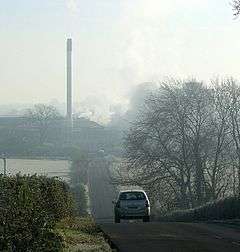Staverton Mill
| Staverton Mill | |
|---|---|
 The mill and chimney in 2007 | |
 Location in Wiltshire, UK | |
| General information | |
| Coordinates | 51°20′51″N 2°12′23″W / 51.347523°N 2.206312°WCoordinates: 51°20′51″N 2°12′23″W / 51.347523°N 2.206312°W |
Staverton Mill is an historic woolen mill and now a cereal factory on the River Avon in the village of Staverton near Trowbridge, Wiltshire in the UK.
History
The mill is first mentioned in the 11th century Doomsday Book as Stavretone: Brictric, formerly his father, from the king. Mill.[1] By the end of the 14th century it had become a fulling mill to meet the burgeoning demand for woolen broadcloth with a stone weir to control flow to the water wheels.[2]
About 1800 the old mill was bought by John Jones. He demolished the old building and erected the current mill.[3] In July 1802 the mill, called the "Staverton Superfine Woolen Manufactory" was attacked as part of a series of disputes about pay.[4]
By 1813 Staverton mill had 40 looms.[5]
In 1897, the mill was sold to the Anglo-Swiss Condensed Milk Co. to facilitate expansion of their condensed milk production,[6] after which the top two stories were removed and the building became offices, a canteen and stores.[7] The new owners replaced the water wheel with a 43 horsepower (32 kW) vortex water turbine and installed equipment including 6-foot (1.8 m) copper vacuum pans, coolers, heaters and a basic filling and packing line.[8]
Anglo-Swiss Condensed Milk Co. became Nestlé in December 1935 and by 1936 local farmers were supplying more than 5,000,000 imperial gallons (23,000,000 l; 6,000,000 US gal) of milk per annum to be condensed at the mill. A new manufacturing block was constructed on the site in 1935 to improve efficiency and the top four stories of the mill building's original six were demolished. Two years later, the workforce had increased to 255. [9]
In 1967 a new plant known as the "baked bean factory" was built on the site for Crosse & Blackwell at a cost of £750,000. The milk cannery closed in 1972 and was refitted as a yoghurt manufacturing plant, dovetailing with Nestlé's 1978 acquisition of the now defunct Chambourcy brand. By 1980 the factory was producing 72 million pots of yoghurt per annum. The Cross & Blackwell factory closed in 1995 and the site was transferred to Cereal Partners.[10]
The site is also the location of the head office of Trapeze Group UK, a supplier of software for public transport management.[11]
The large, landmark chimney at the site was removed in November 2011.[12]
References
- ↑ "Wiltshire P-Z". The Doomsday Book Online. Retrieved 26 July 2015.
- ↑ "Staverton". Wiltshire Community History (Wiltshire Council). Retrieved 26 July 2015.
- ↑ De Lacy Mann, Julia; Harte, N.B.; Ponting, Kenneth G. (1973). Textile History and Economic History: Essays in Honour of Miss Julia de Lacy Mann. Manchester University Press. pp. 182–184. ISBN 9780719005381.
- ↑ Randall, Adrian (2003). Before the Luddites: Custom, Community and Machinery in the English Woollen Industry, 1776-1809. Cambridge University Press. p. 158. ISBN 9780521893343.
- ↑ "The Clothier". Trowbridge Museum. Retrieved 25 July 2015.
- ↑ "Then and Now - Staverton Mill". Wiltshire Times. 25 July 2015. Retrieved 26 July 2015.
- ↑ "Other [Wiltshire] industries". British History Online, University of London. Retrieved 26 July 2015.
- ↑ Porter, Trevor (31 July 2015). "Then and now". Wiltshire Times. p. 45.
- ↑ Porter, Trevor (7 August 2015). "Then and now". Wiltshire Times. p. 41.
- ↑ Porter, Trevor (21 August 2015). "Then and now". Wiltshire Times. p. 83.
- ↑ "Contact Trapeze Group UK | Trapeze Group UK". www.trapezegroup.co.uk. Retrieved 2016-04-06.
- ↑ "Landmark chimney demolished". Wiltshire Times. 11 November 2011. Retrieved 26 July 2015.